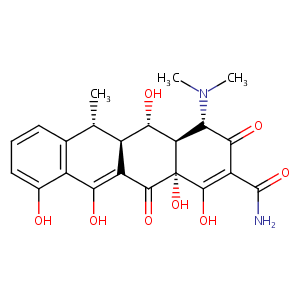| 1 |
ClinicalTrials.gov (NCT00855595) Efficacy of Topical Azelaic Acid 15% Gel Plus Anti-inflammatory Dose Doxycycline or Metronidazole Gel 1% Plus Anti-inflammatory Dose Doxycycline in Moderate Papulopustular Rosacea
|
| 2 |
Doxycycline FDA Label
|
| 3 |
URL: http://www.guidetopharmacology.org Nucleic Acids Res. 2015 Oct 12. pii: gkv1037. The IUPHAR/BPS Guide to PHARMACOLOGY in 2016: towards curated quantitative interactions between 1300 protein targets and 6000 ligands. (Ligand id: 6464).
|
| 4 |
ClinicalTrials.gov (NCT00764361) Safety Study of Topical Doxycycline Gel for Adult Diabetic Lower Extremity Ulcers. U.S. National Institutes of Health.
|
| 5 |
Metronidazole FDA Label
|
| 6 |
FDA Approved Drug Products from FDA Official Website. 2009. Application Number: (NDA) 018517.
|
| 7 |
ClinicalTrials.gov (NCT00509639) Evaluation of Topical 10% Metronidazole Ointment for the Treatment of Active Perianal Crohn's Disease. U.S. National Institutes of Health.
|
| 8 |
Clinical pipeline report, company report or official report of the Pharmaceutical Research and Manufacturers of America (PhRMA)
|
| 9 |
Aryl hydrocarbon receptor protects lung adenocarcinoma cells against cigarette sidestream smoke particulates-induced oxidative stress. Toxicol Appl Pharmacol. 2012 Mar 15;259(3):293-301.
|
| 10 |
Drugs@FDA. U.S. Food and Drug Administration. U.S. Department of Health & Human Services.
|
| 11 |
Mammalian drug efflux transporters of the ATP binding cassette (ABC) family in multidrug resistance: A review of the past decade. Cancer Lett. 2016 Jan 1;370(1):153-64.
|
| 12 |
A further interaction study of quinine with clinically important drugs by human liver microsomes: determinations of inhibition constant (Ki) and type of inhibition. Eur J Drug Metab Pharmacokinet. 1999 Jul-Sep;24(3):272-8.
|
| 13 |
Functional and histochemical analysis of MDR3 P-glycoprotein in a tetracycline-controlled gene expression system. Eur J Med Res. 2000 Dec 29;5(12):517-22.
|
| 14 |
Systems pharmacological analysis of drugs inducing stevens-johnson syndrome and toxic epidermal necrolysis. Chem Res Toxicol. 2015 May 18;28(5):927-34. doi: 10.1021/tx5005248. Epub 2015 Apr 3.
|
| 15 |
Synthesis and in vitro evaluation of targeted tetracycline derivatives: effects on inhibition of matrix metalloproteinases. Bioorg Med Chem. 2007 Mar 15;15(6):2368-74. doi: 10.1016/j.bmc.2007.01.026. Epub 2007 Jan 19.
|
| 16 |
Chloramphenicol causes mitochondrial stress, decreases ATP biosynthesis, induces matrix metalloproteinase-13 expression, and solid-tumor cell invasion. Toxicol Sci. 2010 Jul;116(1):140-50. doi: 10.1093/toxsci/kfq085. Epub 2010 Mar 25.
|
| 17 |
A high-content screen identifies novel compounds that inhibit stress-induced TDP-43 cellular aggregation and associated cytotoxicity. J Biomol Screen. 2014 Jan;19(1):44-56. doi: 10.1177/1087057113501553. Epub 2013 Sep 9.
|
| 18 |
DNA breakage due to metronidazole treatment. Mutat Res. 2001 Jul 1;478(1-2):153-8.
|
| 19 |
Does metronidazole interact with CYP3A substrates by inhibiting their metabolism through this metabolic pathway? Or should other mechanisms be considered? Ann Pharmacother. 2007 Apr;41(4):653-8.
|
| 20 |
Drug-drug interactions for UDP-glucuronosyltransferase substrates: a pharmacokinetic explanation for typically observed low exposure (AUCi/AUC) ratios. Drug Metab Dispos. 2004 Nov;32(11):1201-8.
|
| 21 |
The role of human cytochrome P450 enzymes in the formation of 2-hydroxymetronidazole: CYP2A6 is the high affinity (low Km) catalyst. Drug Metab Dispos. 2013 Sep;41(9):1686-94.
|
| 22 |
Summary of information on human CYP enzymes: human P450 metabolism data. Drug Metab Rev. 2002 Feb-May;34(1-2):83-448.
|
| 23 |
Giardia, Entamoeba, and Trichomonas enzymes activate metronidazole (nitroreductases) and inactivate metronidazole (nitroimidazole reductases). Antimicrob Agents Chemother. 2009 Feb;53(2):458-64.
|
| 24 |
Acetamide--a metabolite of metronidazole formed by the intestinal flora. Biochem Pharmacol. 1979 Dec 15;28(24):3611-5.
|
| 25 |
Overexpression, isotopic labeling, and spectral characterization of Enterobacter cloacae nitroreductase. Protein Expr Purif. 1998 Jun;13(1):53-60.
|
| 26 |
Mechanism of metronidazole-resistance by isolates of nitroreductase-producing Enterococcus gallinarum and Enterococcus casseliflavus from the human intestinal tract. FEMS Microbiol Lett. 2003 Aug 29;225(2):195-200.
|
| 27 |
Isolation of metronidazole-resistant Bacteroides fragilis carrying the nimA nitroreductase gene from a patient in Washington State. J Clin Microbiol. 2004 Sep;42(9):4127-9. Case Reports
|
| 28 |
An in vitro coculture system of human peripheral blood mononuclear cells with hepatocellular carcinoma-derived cells for predicting drug-induced liver injury. Arch Toxicol. 2021 Jan;95(1):149-168. doi: 10.1007/s00204-020-02882-4. Epub 2020 Aug 20.
|
|
|
|
|
|
|


